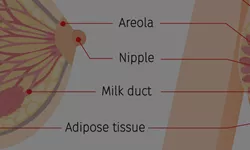This article is part of a series on breast milk's nutrition facts.
Why is fat so important in breast milk? How can I increase my milk's fat content?
Q: I keep being told that my breast milk is too watery and doesn't contain enough fat or nutrition in general. How can I judge if that's true or not? Is fat actually important in breast milk? And if is, how do I increase the fat content of my breast milk?
A: Fats account for about 4.4% of your breast milk's weight but for about 60% of its calories.
Fats are crucial to your baby's development
Fats are crucial as they contain many elements essential to your baby's growth. For instance long-chain polyunsaturated fatty acids (LC-PUFA), a specific type of fats, are widely believed to be a key reason why breast-fed infants perform better on tests that assess neurodevelopmental outcomes than do formula-fed infants.1 In short, they're believed to help develop your little one's brain better than if they were fed formula.
The fat in your milk comes partly from your waist!
Where is the fat in your breast milk coming from? From the food you eat and... your waist! A study from the University of Pittsburgh found that women who had not breastfed had an average of about 3 additional inches (7.5cm) of fat around their waists.2 The same study found that women who had children but did not breastfed had 28 percent more visceral fat in their midsection than those who had consistently breastfed.2
This also helps nursing mums later in life. It is a key reason why the longer women breastfeed their children, the less likely they are to get type 2 diabetes, regardless of BMI.3
Your diet determines the quality of your breast milk's fats
Your diet of course also impacts the fats in your breast milk, it doesn't just come from your waist! Interestingly it doesn't affect the level of fat in your milk as much as the types of fats it contains. In other words even if you eat a very fatty diet, the amount of fat in your milk isn't going to substantially increase4.
What will change is the quality of your milk's fats and that is why you should be careful to eat good-quality fats. Examples include fatty fish (mackerel, salmon, herring, sardines, etc.) or plants which contain good fats such as walnuts, flax seeds, chia seeds, soybeans, etc. Fats to avoid are your typical saturated fats contained in cakes, biscuits, sausages, cured meats, etc.
How to determine the fat content in your milk
You can determine whether your breast milk contain a lot of fat based on the amount of cream that floats on top.5
This is because lipids (fats) are not soluble in water and will therefore naturally float on top if you let your milk undisturbed during a certain laps of time.
Another way to judge the fat content in your milk is by its color. If it has a grey-bluish tint to it, it contains very little fat. If on the contrary it's yellow-white, the fat content is higher. In fact the more yellow your milk, the more fat it contains.

The thickness of the cream on top of your breast milk indicates the level of fat
Fats are mostly in hindmilk, at the end of a breastfeeding session
Interestingly the amount of fat in your milk is very much determined by whether you properly empty your breasts or not. During a breastfeeding or pumping session, the amount of lipids in your breast milk gradually increases as time goes on. We refer to the milk at the beginning of a pumping session as "foremilk": it tends to be thinner in texture and often has a grey/bluish hue. As your pumping goes on, your milk progressively becomes "hindmilk": it becomes ticker, creamer and has a more white/yellowish tone. This is because it has much more fats/lipids in it than foremilk.
In order for your little one to have all the nutrition they need during each feeding, we therefore recommend you empty your breasts every time. Like that your baby will get both foremilk and hindmilk.
How to improve the nutritional quality of your milk
To improve the quality of your breast milk we strongly recommend you drink Milk Boost Tea. It's an ancestral recipe of 13 natural herbs that's been used for centuries by nursing mums in Asia to boost their milk volume and its nutritional value.
For instance it contains Dong Quai, a root also known as the "female ginseng" for its wide range of health benefits for women. It also contains Longans, famous for nourishing the blood and helping nursing women recover from childbirth.

Milk Boost Tea is a natural herbal tea that can help you improve your milk volume and its nutritional value
You might also be interested by the other articles in our series about breast milk's nutrition facts:
- How many calories are there in breast milk?
- What are breast milk's nutrition facts? What is it composed of?
- Are colostrum's nutrition facts the same as breast milk?
- Does formula have more calories than breast milk?
- How much proteins are there in breast milk?
- How much carbohydrates are there in breast milk?
Sources:
1. Gibson RA, Makrides M. Long-chain polyunsaturated fatty acids in breast milk: are they essential? Adv Exp Med Biol. 2001;501:375-83. doi: 10.1007/978-1-4615-1371-1_46. PMID: 11787705.
2. Mcclure, Candace & Schwarz, Eleanor & Conroy, Molly & Tepper, Ping & Janssen, Imke & Sutton-Tyrrell, Kim. (2011). Breastfeeding and Subsequent Maternal Visceral Adiposity. Obesity (Silver Spring, Md.). 19. 2205-13. 10.1038/oby.2011.185.
3. Stuebe AM, Rich-Edwards JW, Willett WC, Manson JE, Michels KB. Duration of Lactation and Incidence of Type 2 Diabetes. JAMA. 2005;294(20):2601–2610. doi:10.1001/jama.294.20.2601
4. Hamosh M, Dewey, Garza C, et al: Nutrition During Lactation. Institute of Medicine, Washington, DC; National Academy Press 1991.
5. Wang CD, Chu PS, Mellen BG, and Shenat JP. 1999. Creamotocrit and the nutrient composition of human milk. Journal of Perinatology 19(5): 343-346.
Article tags: Breastfeeding and maternity








